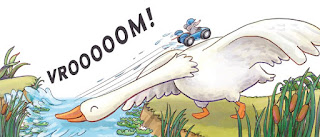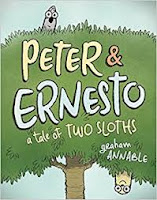 |
| Photo provided by Sylvie Shaffer |
Today's contributor, Sylvie Shaffer, served on the 2018 Geisel Committee. She’s the preK-8 librarian at the Capitol Hill Day School in Washington, DC and is active in several overlapping kidlit-focused communities including ALSC and Capitol Choices. She is currently serving on the Sydney Taylor Book Award and is busy parenting her own five year old emerging reader with help from her wife in Takoma Park, Maryland where she also serves on the Board of the Friends of her local library.
 |
| Cover art from Chroniclebooks.com |
Miles and Spike set off on the titular hike on the book’s title page, and continue pillaging resources from and dismissively bidding animals farewell as they stuff their increasingly full pack until they can no longer carry it. The pair’s realization that they can’t lift their pack, along with the animals’ collective response, forces them to realize- and remedy- their wrongdoings.
Much of the story is told through Travis Foster’s deceptively simple illustrations, which feature monochromatic backgrounds that highlight each scene’s full-color interaction between Miles, Spike, and whichever animals they are currently insulting. Each illustration also shows in muted tones matched to the background colors, the ever-growing mob of seething critters the pair has angered along the way. This artistic choice helps beginning readers track the story’s arc and serves well both as a running visual gag and as a reminder of the text’s rhythm and rhyme pattern.
 |
| Photos by Sylvie Shaffer |
A number of details around word choice elevate this picture book to Geisel contender. The repeating pattern of “See you later, Alligator” type phrases is established from the first pages and maintained throughout the text, save for a few pages - one with a nonsense sound that’s fun for readers, and the other featuring two simple words, “pant” and “drip” repeated five times each. Each of these two pages gives readers who’ve been working hard in the preceding pages a chance to rest and feel successful. Note, though, that even the few trickier, longer creature names (Dragonfly, Gazelle) are easily decodable. And perfectly upholding the Geisel criteria, if the book’s emerging reader is still stuck, the cartoony illustrations offer clues. Perhaps the most useful feature of the book as a reading primer is that rhymes utilize the same letter combinations only half the time, reinforcing to early readers that there are multiple ways of spelling the same sound. (dumb/chum; again/then; here/deer)

Canine pals Miles and Spike’s characters are well-developed in the first half of the story through their careless and dismissive words and actions towards the other animals in the forest. When the pair realize the errors of their ways, they undergo a true and believable change of heart and try again, mending relationships with the animals they’d hurt, and sharing messages with the book’s beholders about the importance of owning one’s mistakes, “We acted dumb, chum.”, the power of inclusivity, “Join the fun, EVERYONE!”, and trying again when you get something wrong the first time.

While the book’s messages are both valuable and conveyed in a not-too-overly-didactic way, they hold no bearing on its Geisel eligibility...except maybe that last one, about trying again...thematically, I see echos of Laurie Keller’s 2017 Geisel winner, “We Are Growing.” Specifically, the idea that personal growth is a journey of stopping, starting, and trying again is one that closely mirrors the process of learning to read, of sounding words out, maybe getting them wrong along the way. In addition to this message of resilience, Take a Hike, shares many markers and conventions - regarding both text and illustration- apparent in many prior Geisel winners and honors: a tight word count (under a hundred!) highly effective use of dialogue bubbles, repetition of patterns including rhyme, shifting a lot of the heavy lifting of storytelling to the illustrations, humor, and anthropomorphization. And, of course, Ethan Long has already been awarded the Geisel Gold medal for “Up, Tall, and High”...could this book earn him a second gold, tying Willems for Geisel wins?
I think so...watch out Mo!
Overlook this book?
It’d be a pity, real committee!





















